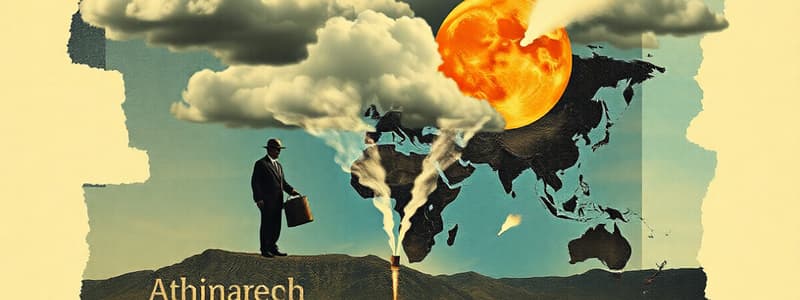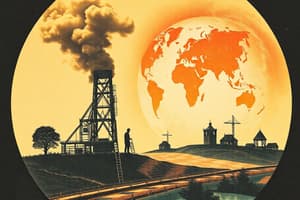Podcast
Questions and Answers
During an El Niño event, which of the following weather patterns is most likely to be observed in the southern states?
During an El Niño event, which of the following weather patterns is most likely to be observed in the southern states?
- Reduced rainfall and cooler temperatures.
- Drier conditions and warmer temperatures.
- Consistent temperatures and average rainfall.
- Increased rainfall and cooler temperatures. (correct)
Under normal climate conditions in the Pacific Ocean, how does warm ocean water primarily circulate?
Under normal climate conditions in the Pacific Ocean, how does warm ocean water primarily circulate?
- Warm water circulates eastward towards South America.
- Warm water remains stationary, causing localized heating.
- Warm water sinks to deeper ocean levels near the equator.
- Warm water circulates westward away from South America. (correct)
If a continent that was once located near the equator drifts towards the poles over millions of years, what is the most likely long-term climatic consequence for that continent?
If a continent that was once located near the equator drifts towards the poles over millions of years, what is the most likely long-term climatic consequence for that continent?
- Its climate will remain unchanged due to consistent geothermal activity.
- It will transition to a cooler climate due to decreased solar radiation. (correct)
- It will experience consistently warmer temperatures due to increased solar radiation.
- Its climate will become drier due to reduced ocean proximity.
Which process primarily causes rainfall on the windward side of a mountain range in the orographic effect?
Which process primarily causes rainfall on the windward side of a mountain range in the orographic effect?
The rain shadow effect is characterized by dry conditions occurring on which side of a mountain and due to what atmospheric process?
The rain shadow effect is characterized by dry conditions occurring on which side of a mountain and due to what atmospheric process?
How does the burning of fossil fuels by humans primarily contribute to global warming?
How does the burning of fossil fuels by humans primarily contribute to global warming?
Besides burning fossil fuels, which other human activities significantly alter Earth's climate by affecting the water cycle and air circulation?
Besides burning fossil fuels, which other human activities significantly alter Earth's climate by affecting the water cycle and air circulation?
Which of the following activities would contribute most significantly to long-term climate change, as opposed to short-term weather patterns?
Which of the following activities would contribute most significantly to long-term climate change, as opposed to short-term weather patterns?
Why is tracking weather patterns over approximately 30 years necessary to establish the climate of a region?
Why is tracking weather patterns over approximately 30 years necessary to establish the climate of a region?
Which of the following is the most accurate comparison between weather and climate?
Which of the following is the most accurate comparison between weather and climate?
How does atmospheric circulation contribute to the distribution of heat around the Earth?
How does atmospheric circulation contribute to the distribution of heat around the Earth?
What is the primary role of the greenhouse effect in regulating Earth's climate?
What is the primary role of the greenhouse effect in regulating Earth's climate?
How do oceans influence global climate patterns?
How do oceans influence global climate patterns?
If the Earth's axial tilt were significantly reduced, what would be a likely consequence on global climate?
If the Earth's axial tilt were significantly reduced, what would be a likely consequence on global climate?
Which scenario would most directly demonstrate the impact of human activities on climate change?
Which scenario would most directly demonstrate the impact of human activities on climate change?
Flashcards
Climate
Climate
The long-term pattern of weather in a specific location.
Weather
Weather
Short-term atmospheric conditions, that can change rapidly.
Climate Change
Climate Change
Changes in long-term weather patterns, influenced by human and natural activities.
Atmospheric Circulation
Atmospheric Circulation
Signup and view all the flashcards
Greenhouse Effect
Greenhouse Effect
Signup and view all the flashcards
Uneven Heat Distribution
Uneven Heat Distribution
Signup and view all the flashcards
Ocean Heat Storage
Ocean Heat Storage
Signup and view all the flashcards
Factors Affecting Climate
Factors Affecting Climate
Signup and view all the flashcards
El Niño
El Niño
Signup and view all the flashcards
Continental Drift
Continental Drift
Signup and view all the flashcards
Orographic Effect
Orographic Effect
Signup and view all the flashcards
Rain Shadow Effect
Rain Shadow Effect
Signup and view all the flashcards
Global Warming
Global Warming
Signup and view all the flashcards
Fossil Fuels Impact
Fossil Fuels Impact
Signup and view all the flashcards
Deforestation & Agriculture
Deforestation & Agriculture
Signup and view all the flashcards
Study Notes
- Climate represents the long-term weather patterns of a specific location, typically established over 30 years.
- Human activities, like burning fossil fuels, contribute to climate change by increasing Earth's surface temperature.
- Natural events such as volcanic activity and ocean cycles can also cause climate change.
Atmospheric Effects
- Atmospheric circulation impacts climate due to temperature differences between Earth's poles and equator.
- Solar radiation is stronger at the equator, resulting in higher temperatures compared to the poles.
- Warm air rises at the equator, cools in the atmosphere, and descends near the poles, creating global wind patterns.
- The greenhouse effect occurs when gases in the atmosphere trap heat from the sun which warms the Earth and sustains life.
Heat Distribution
- Air circulation and global wind patterns help distribute heat across the Earth, which affects average temperatures.
- The equator receives more direct solar radiation, making it warmer than the poles.
- Oceans store and transport heat; water near the equator absorbs heat and moves towards the poles.
- As water approaches the poles, it releases heat into the atmosphere, then returns to the equator to repeat the cycle.
- El Niño is a Pacific Ocean weather event where winds move warm water eastward, occurring every two to seven years and can cause cooler, rainier winters in the southern states.
Landforms and Continents
- Continental drift, the slow movement of Earth's tectonic plates, influences climate over long periods.
- Continents moving from the equator towards the poles experience a shift from warm to cooler climates.
- The orographic effect happens when air masses meet mountain ranges, causing the air to rise, cool, and produce rainfall.
- A rain shadow effect occurs on the leeward side of mountains due to descending warm air absorbing moisture and creating a dry area.
Human Influence
- Burning fossil fuels releases gases like carbon dioxide, which trap heat and cause global warming.
- Deforestation and agricultural practices disrupt the Earth's water cycle and air and warm water circulation, also greatly changing the overall climate.
Studying That Suits You
Use AI to generate personalized quizzes and flashcards to suit your learning preferences.
Description
Explore the factors influencing Earth's climate, including human activities and natural events. Understand atmospheric circulation and the greenhouse effect, vital for heat distribution. Discover how solar radiation and wind patterns shape our planet's average temperatures.



